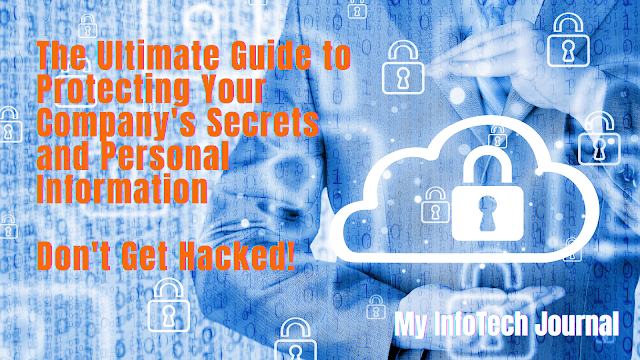The Ultimate Guide to Protecting Your Company's Secrets and Personal Information - Don't Get Hacked!
My InfoTech Journal:
The Ultimate Guide to Protecting Your Company's Secrets and Personal Information - Don't Get Hacked!
In today's digital world, company confidential information and sensitive personal information are increasingly vulnerable to unauthorized access, theft, and exploitation.
This poses a significant risk to the reputation and financial stability of organizations.
Therefore, it is essential to take proactive measures to secure this data and comply with relevant regulations and standards.
What is Company Confidential Information and Sensitive Personal Information?
Company Confidential Information (CCI) is any data that is not meant to be shared publicly or with unauthorized individuals. This could include financial data, strategic plans, intellectual property, customer lists, and other trade secrets.
Sensitive Personal Information (SPI) is any data that could potentially harm an individual if disclosed, such as Social Security numbers, health information, and financial information.
Risks and Remediation
The risks associated with the loss or misuse of company confidential information and sensitive personal information are significant.
The costs can be both financial and reputational.
In the worst-case scenario, a data breach could result in legal action, regulatory fines, and long-term reputational damage.
One remedy to mitigate the risks of a data breach is to implement a security plan that includes encryption, firewalls, and access controls.
Organizations should regularly update and maintain their security systems to stay ahead of emerging threats.
Additionally, training employees to follow best practices and maintaining a culture of security can help prevent data breaches.
Securing Company Confidential Information and Sensitive Personal Information
To secure company confidential information and sensitive personal information, organizations must understand the threats and vulnerabilities they face.
Threats could come from both internal and external sources, including hackers, insiders with malicious intent, and third-party vendors.
Common vulnerabilities include weak passwords, outdated software, and unsecured wireless networks.
To address these vulnerabilities, organizations should establish security protocols, including multi-factor authentication, encryption, and access control policies.
Additionally, regular security audits should be conducted to identify areas that need improvement.
Audit Compliance and Reporting
Compliance with relevant regulations and standards is essential for protecting company confidential information and sensitive personal information.
Some of the most common regulations include the General Data Protection Regulation (GDPR) in the European Union, the Health Insurance Portability and Accountability Act (HIPAA) in the United States, and the Personal Information Protection and Electronic Documents Act (PIPEDA) in Canada.
Organizations must regularly assess their compliance with relevant regulations and report any breaches that occur to the appropriate authorities.
In some cases, organizations may also be required to notify affected individuals.
Conclusion
In conclusion, securing company confidential information and sensitive personal information is essential for maintaining an organization's reputation and financial stability.
To mitigate the risks of a data breach, organizations must understand the threats and vulnerabilities they face, implement security protocols, comply with relevant regulations, conduct regular audits, and maintain a culture of security.
With these measures in place, organizations can protect themselves and their customers from the devastating effects of a data breach.
Disclaimer
This article is a result of my personal research and is not a substitute for legal advice. Please consult your Information Security Team, Legal Team, Ethics & Compliance, or Regulatory Team for the interpretation of specific Information Security requirements.



Comments
Post a Comment